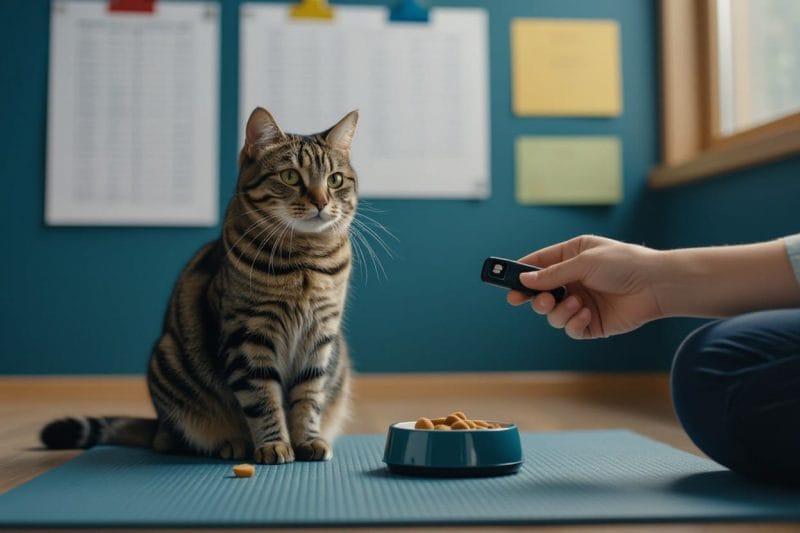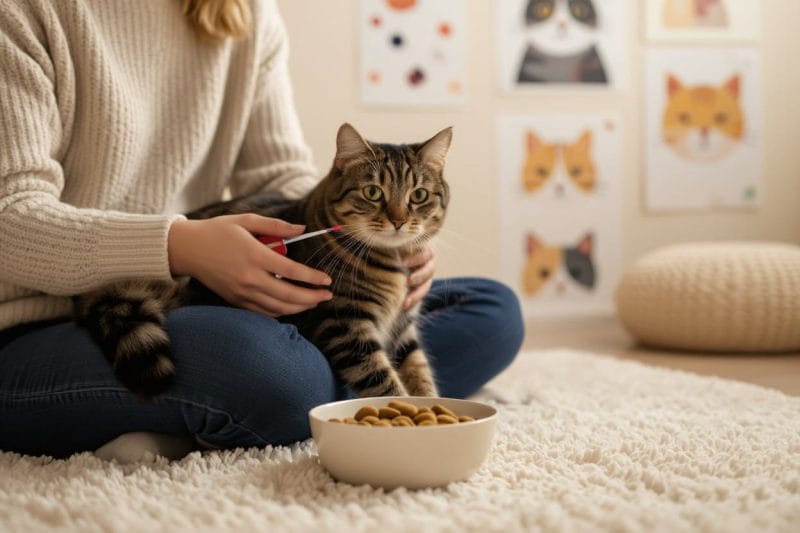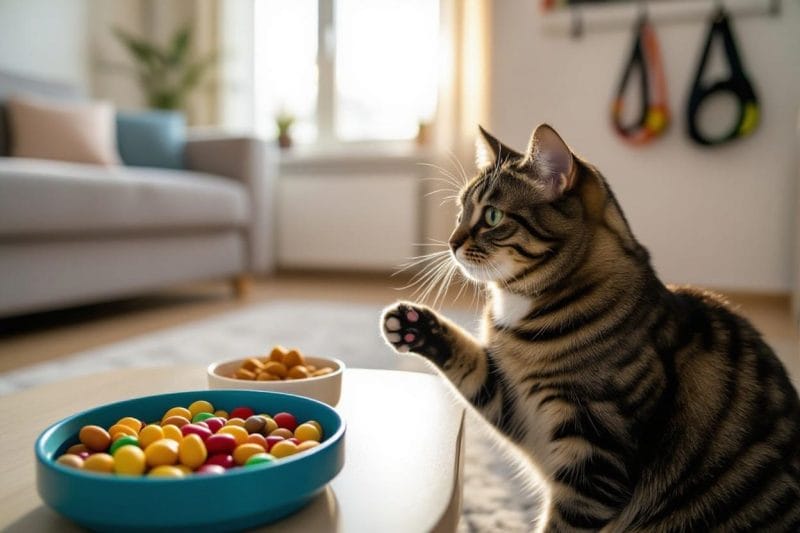With patience and consistency, you can successfully teach your cat obedience skills that improve your relationship and create a harmonious home. By understanding your cat’s behavior and using simple techniques, you can guide your feline friend to respond to commands and develop better habits. This post will walk you through four straightforward methods that make obedience training manageable and effective for you and your cat. Whether you’re a seasoned cat owner or new to feline care, these tips will empower you to master training with ease.

The Misconceptions About Cat Training
Many cat owners mistakenly believe training is an impossible task, rooted in myths about feline nature rather than facts. You’ll often hear that cats are too independent or indifferent to respond to obedience training like dogs. However, these misconceptions prevent you from unlocking your cat’s true potential. Real-world examples show cats learning commands such as “sit” or “stay” through consistent, gentle methods. Understanding and addressing these false beliefs opens the door to a more cooperative and harmonious relationship between you and your feline friend.
Debunking the Myth of Feline Independence
While cats may appear aloof, scientific studies reveal they form complex social bonds and respond well to training when motivated. Unlike the stereotype of complete independence, cats often seek interaction and approval. Your cat’s seeming indifference sometimes masks a personal choice not to engage, not a lack of ability. Offering rewards like treats or playtime can transform that seemingly stubborn behavior into enthusiastic participation, breaking down the barrier of misunderstood feline independence.
Understanding the Cats’ Learning Process
Cats learn primarily through positive reinforcement and repetition; they respond best to rewarding experiences rather than punishment. Training sessions that are short and frequent fit their naturally short attention spans of about 5-10 minutes. Your consistency and timing in providing rewards immediately after the desired behavior greatly impact how quickly your cat learns. Recognizing subtle signs of engagement helps tailor your approach, ensuring your cat feels motivated rather than pressured.
Diving deeper, cats process information in a way that favors associative learning—they link actions with outcomes rather than commands alone. That means clear, consistent cues paired with immediate rewards help your feline connect the dots faster. Unlike dogs who respond well to commands delivered verbally, cats often respond better to visual or tactile cues combined with treats or affectionate petting. Adjusting to this learning style and integrating it into your daily interactions enhances obedience training effectiveness, making every effort more fruitful and enjoyable for both you and your cat.

The Power of Positive Reinforcement
Positive reinforcement transforms obedience training from a battle of wills into a collaborative game. By rewarding your cat immediately after displaying the desired behavior, you reinforce that action’s benefits. Studies show cats associate treats or affection with specific behaviors within seconds, speeding up learning. Instead of punishing unwanted actions, rewarding good ones encourages repetition, building trust and enthusiasm in your feline friend. This approach not only accelerates mastery but strengthens your bond, making training sessions something your cat looks forward to.
Choosing Appropriate Rewards
Finding the right reward hinges on your cat’s preferences. While some kitties drool over bits of cooked chicken or commercial cat treats, others respond better to affection like gentle petting or verbal praise. Experiment with varieties: soft treats, kibble, or even a favorite toy can serve as incentives. Matching the reward to the behavior’s difficulty helps—more challenging tasks deserve more enticing rewards. Observing what excites your cat ensures each reinforcement feels meaningful, maximizing training effectiveness.
Timing Makes All the Difference
Deliver rewards instantly following the behavior to solidify the connection in your cat’s mind. A delay of even a few seconds can blur the association, causing confusion. For example, if you’re teaching “sit,” reward the moment your cat’s rear touches the floor. Using a clicker or a consistent verbal cue paired with treats acts as precise markers, bridging any brief gaps between behavior and reward. Proper timing accelerates learning by clarifying which specific action earned the praise.
Precision in timing can be supported by using a marker like a clicker, which emits a consistent, distinct sound that pinpoints the exact moment your cat performs the desired behavior. This immediate feedback sharpens your cat’s understanding beyond what treats alone can convey. Coupled with treats dispatched right after the click, this method leverages your cat’s quick cognitive processing ability. Maintaining this timing consistency during training sessions means your cat learns to link behavior and reward seamlessly, often within fewer repetitions than traditional methods.
Building a Training Routine
You can dramatically improve your cat’s obedience by setting up a regular training routine tailored to their natural rhythms. Consistency helps your cat anticipate and engage actively during sessions, making commands easier to learn and recall. Aim for short, frequent sessions—typically five to ten minutes—to keep your cat interested without overwhelming them. Over time, this predictable pattern builds trust and reinforces learning, transforming sporadic efforts into a reliable training regimen that fits seamlessly into daily life.
Establishing a Consistent Schedule
Choose specific times each day to work with your cat, ideally when they are naturally more alert, such as after a nap or meal. Training sessions between the hours of 10 am and 4 pm often work well, as cats are neither too energetic nor too sleepy. Sticking to this schedule not only conditions your cat to expect training but also helps you build momentum. Over weeks, your cat’s responsiveness will improve, making even complex behaviors easier to teach.
Incorporating Training into Playtime
Blending obedience training with interactive play keeps your cat engaged and motivated. Use toys like feather wands or laser pointers to prompt actions such as “come” or “sit,” rewarding compliance with play rewards instead of just treats. By tying commands to activities your cat enjoys, you make training fun and less like a chore. In practice, a quick game of chase can become an opportunity to practice recall and focus, sharpening obedience in an enjoyable, low-stress setting.
Beyond simply making training fun, integrating play helps associate commands with immediate positive outcomes tailored to your cat’s interests. For example, if your cat loves chasing a laser pointer, start each session by issuing a command like “sit” before allowing them to chase it. Gradually increase the complexity by requiring multiple commands during play, which reinforces discipline while maintaining high energy and enthusiasm. This method reduces frustration and accelerates learning by leveraging your cat’s natural hunting instincts.
Mastering Command Basics for Cats
Starting with clear, consistent signals lays the foundation for effective training. Cats respond best when commands are simple and paired with positive reinforcement like treats or affection. Use the same word or cue every time to avoid confusion. For instance, saying “come” while gently patting your lap helps your cat link the command with the action. Keep training sessions brief, about 5 minutes, to maintain your cat’s attention and encourage steady progress.
Essential Commands Every Cat Should Know
Commands such as “come,” “sit,” “stay,” and “leave it” form a useful toolkit for daily interactions. Teaching your cat to come when called helps with safety and bonding, while “stay” can prevent unwanted behaviors. “Leave it” proves valuable for avoiding dangerous objects or food. Creating these habits improves communication and helps your cat navigate your home environment comfortably and respectfully.
Troubleshooting Common Training Challenges
Some cats may initially ignore commands or become easily distracted, especially in stimulating environments. Variations in motivation, like hunger or mood, affect responsiveness. If your cat struggles with focus, try shortening sessions or increasing rewards. Avoid punishment, as it undermines trust and can discourage participation. Tracking progress in a training journal might help identify patterns and tailor your approach effectively.
Dealing with setbacks often involves adjusting timing and reinforcement types. For example, if treats lose their appeal, experiment with different flavors or toys as rewards. Repetition is key, but so is patience — some cats require weeks to consistently obey a new command. Environmental modifications, such as reducing background noise or training in a quiet room, can minimize distractions that hinder learning. Understanding your cat’s unique personality and preferences plays a significant role in overcoming these training hurdles successfully.

Transforming Training Sessions into Bonding Moments
Training your cat becomes far more effective when it doubles as quality time. Each session offers a unique chance to understand your cat’s moods and preferences while reinforcing positive behaviors. Gradually, these interactions evolve beyond simple commands into shared experiences that deepen your mutual trust and affection. Tailor sessions to your cat’s energy levels, keeping them short and fun to sustain your cat’s interest, and celebrate small achievements to keep motivation high on both ends.
Creating a Positive Environment
Set up a distraction-free, comfortable space that your cat associates with positive experiences. Use familiar toys and treats to encourage engagement, and schedule sessions when your cat is naturally more receptive, often after rest or playtime. Soft lighting and minimal noise help maintain focus and reduce stress. The goal is to make your cat feel safe and curious, turning the training area into a pleasant, inviting spot where learning feels enjoyable rather than pressured.
Strengthening the Human-Feline Relationship
Training sessions build more than obedience; they nurture your bond through shared communication. Use gentle tones, consistent rewards, and patient gestures to create a language your cat understands and trusts. Over time, you’ll notice your cat approaching you with openness, signaling comfort and willingness to connect. By recognizing your cat’s unique personality and respecting its pace, you cultivate a relationship marked by mutual respect and affection.
Beyond learning commands, consistently rewarding your cat’s efforts fosters an atmosphere of encouragement and understanding. When you mirror your cat’s playfulness or relaxation cues during training, it bridges the emotional gap, making your interactions feel more like cooperative play than strict instruction. This approach improves your cat’s responsiveness and enriches your daily interactions, turning occasional training into a continuous exchange of companionship and insight.
Summing up
With this in mind, mastering obedience training for your cat becomes a manageable and rewarding task when you focus on consistency, positive reinforcement, simple commands, and patient repetition. By dedicating time to understand your cat’s unique personality and needs, you can effectively encourage desirable behaviors that benefit both you and your feline companion. Your efforts will foster a stronger bond and create a harmonious living environment, making everyday interactions smoother and more enjoyable for both of you.
FAQ
Q: Is it possible to train a cat like a dog?
A: Yes, cats can be trained, but their motivation and learning style differ from dogs. Patience, positive reinforcement, and consistent practice are key in cat obedience training.
Q: What are the best rewards to use during cat obedience training?
A: Treats that your cat enjoys, such as small pieces of meat or specially formulated cat treats, work best. Additionally, affection, playtime, and verbal praise can serve as effective rewards.
Q: How long does it typically take to see results in cat obedience training?
A: It varies by cat, but most cats show noticeable improvements within a few weeks of consistent training, especially when sessions are kept short and positive.
Q: Can clicker training be used to teach cats obedience commands?
A: Yes, clicker training is an excellent tool for cats. The click sound marks the desired behavior, which helps cats quickly associate the action with a reward.
Q: How often should I train my cat each day?
A: Short sessions of about 5 to 10 minutes, two to three times daily, are most effective. Frequent, brief training helps maintain your cat’s interest and prevents frustration.
Q: What are four easy methods to train my cat in obedience?
A: Four accessible methods include using positive reinforcement, clicker training, teaching basic commands like “sit” or “come,” and establishing a consistent daily training schedule.
Q: Are there specific behaviors that are easier to train in cats?
A: Yes, behaviors related to natural instincts, such as responding to their name, sitting, or coming when called, are generally easier to teach compared to complex tricks.










